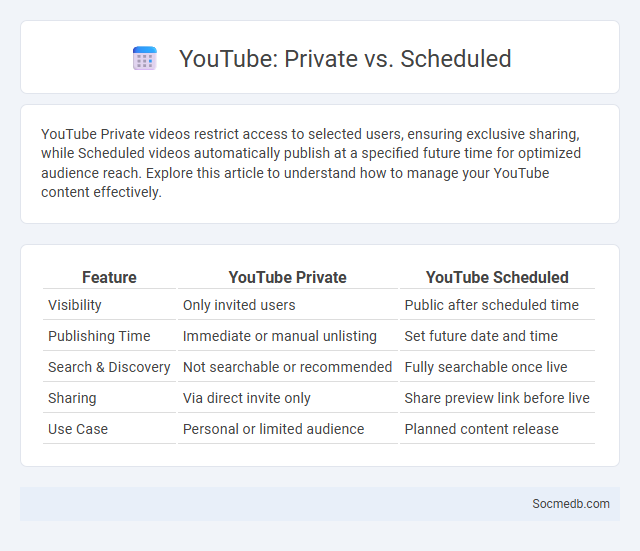
Photo illustration: YouTube Private vs Scheduled
YouTube Private videos restrict access to selected users, ensuring exclusive sharing, while Scheduled videos automatically publish at a specified future time for optimized audience reach. Explore this article to understand how to manage your YouTube content effectively.
Table of Comparison
| Feature | YouTube Private | YouTube Scheduled |
|---|---|---|
| Visibility | Only invited users | Public after scheduled time |
| Publishing Time | Immediate or manual unlisting | Set future date and time |
| Search & Discovery | Not searchable or recommended | Fully searchable once live |
| Sharing | Via direct invite only | Share preview link before live |
| Use Case | Personal or limited audience | Planned content release |
Introduction to YouTube Video Privacy Options
YouTube offers a range of video privacy options to control who can view your content, including Public, Unlisted, and Private settings. Public videos are accessible to everyone, while Unlisted videos can only be seen by those with a direct link, enhancing selective sharing. Private videos restrict access to specific users you choose, giving you full control over your digital footprint and ensuring Your content is shared with intended viewers only.
What is a YouTube Private Video?
A YouTube private video is a video setting that restricts access solely to users explicitly invited by the uploader, preventing it from appearing in search results, playlists, or public channels. Only viewers with specific permissions can watch the content, ensuring privacy and controlled sharing. This feature is ideal for sharing sensitive or personal videos without exposing them to the wider YouTube audience.
Key Features of YouTube Scheduled Videos
YouTube Scheduled Videos enable creators to plan content releases at specific dates and times, increasing audience engagement by delivering videos when viewers are most active. This feature supports seamless content management by allowing you to maintain a consistent posting schedule without manual intervention. Scheduled videos also integrate with YouTube analytics, helping optimize future uploads based on performance data and viewer behavior patterns.
Understanding Unlisted vs. Private vs. Scheduled
Understanding the differences between unlisted, private, and scheduled social media posts is crucial for managing your online presence effectively. Unlisted posts are accessible only via direct links and do not appear in public searches, while private posts restrict visibility to specific users or groups you select. Scheduled posts allow you to plan content ahead of time, ensuring consistent engagement by automatically publishing at your chosen date and time.
How to Set Your YouTube Video as Private
To set your YouTube video as private, access YouTube Studio and navigate to the "Content" section where your uploaded videos are listed. Click on the video you want to modify, then find the "Visibility" settings on the right panel, choosing "Private" from the options available. Your video will then be restricted, allowing only invited users to view it, ensuring your content remains confidential.
Benefits of Scheduling YouTube Videos
Scheduling YouTube videos allows you to maintain a consistent posting routine, which can boost viewer engagement and improve channel growth. Automated publishing helps target optimal times when your audience is most active, increasing video visibility and watch time. This strategic approach also frees up your time for content creation and community interaction, enhancing your overall social media management.
Comparing Private and Scheduled Videos: Which to Choose?
Private videos offer exclusive access to your content, ensuring only selected viewers can watch, which enhances control over your audience and helps protect sensitive information. Scheduled videos allow you to plan content releases strategically, optimizing viewer engagement by publishing at peak times without manual intervention. You should choose private videos for targeted sharing and scheduled videos to maintain consistent content delivery and maximize reach.
Managing Access: Who Can View Each Type?
Managing access on social media platforms involves configuring privacy settings to control who can view different types of content such as posts, stories, and profile information. Users can customize visibility options to restrict access to friends, specific groups, or the public, ensuring sensitive information remains confidential. Advanced features like friend lists, custom audience selection, and blocking enhance security by granting precise control over content exposure.
Tips for Maximizing YouTube Video Privacy Settings
Adjusting YouTube video privacy settings ensures controlled access and enhances content security. Setting videos to "Private" restricts visibility to selected users, while "Unlisted" allows access only via direct links, preventing public search indexing. Leveraging these settings, along with managing playlist visibility and disabling comments, optimizes privacy and user interaction tailored to your audience.
FAQs: Private, Scheduled, and Unlisted YouTube Videos
Private YouTube videos are visible only to users you invite, ensuring your content remains restricted to a select audience. Scheduled videos allow you to set a specific publish date and time, helping you plan your content release strategically for maximum engagement. Your Unlisted videos won't appear in search results or on your channel, but anyone with the direct link can view and share them, giving you control over distribution without full public exposure.
 socmedb.com
socmedb.com